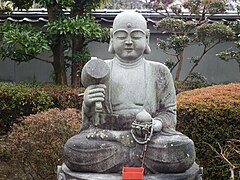Sairin-ji (Matsuyama)
The Sairin-ji ( Japanese 西林 寺 ) with the Go Seiryūzan ( 清 滝 山 ) and An'yōin ( 安 養 院 ) is a temple of the Buzan direction ( 豊 山 派 ) of Shingon Buddhism in the city of Matsuyama (Ehime Prefecture). In the traditional count, it is the 48th temple on the Shikoku pilgrimage route .
history
According to tradition, the temple was built at the request of the emperor Shōmu in Tempyō 13 (742) by priest Gyōki , together with the provincial administrator Prince Ochi no Tamazuki ( 越 智 玉 純 ) as a temple at a shrine, in today's Onoharimazuka, for example on “Tokui no sato” ( 徳 威 の 里 ). The main cult figure was an eleven-faced Kannon . In 807, priest Kūkai passed here on his tour of Shikoku and, with the support of the provincial administrator Ochi no Sanekatsu ( 越 智 実 勝 ), moved the temple to its present location.
At that time the village where the temple was located was hit by a great drought. Kūkai thrust his pilgrim's staff into the earth, from which water immediately began to gush vigorously. 300 m southwest of the temple, the depression ( 杖 淵 Tsue fo fuchi ) created by the rod can still be seen today. In 1985 the water from this spring was chosen as one of the "Hundred Excellent Waters of Japan" ( 全国 の 名 水 百 選 Zenkoku no meisui hyakusen ).
At the beginning of the Edo period , the temple burned down in the Kanei era (1624-1644). It was not until 1700 that it was at least partially rebuilt by Matsudaira Iki no Kami ( 松 平 壱 岐 壱 ) and others. When in 1707 priest Kakuei ( 覚 栄 法 印 ) was able to redeem the residents waiting for rain by asking them to come, he brought them back to faith. They then supported him in rebuilding the main hall and the bell tower. Towards the end of the Endo period, the Daishidō Hall and the Niō Gate could also be rebuilt.
The attachment
A small bridge over a ditch leads to the temple gate, which is designed here as a Niō gate ( 仁王 門 Niō-mon ; 1), i.e. as a gate with space for the two temple guards (Niō) to the right and left of the passage. After passing the guest area (A) of the temple, the bell tower is on the left ( 鐘楼 Shōrō ; 2). Ahead you can see the main hall ( 本 堂 Hondō ; 3) and to the right of it, the hall dedicated to the temple founder, the Daishidō ( 大師 堂 ; 4).
Other buildings include the Emmadō ( 閻 魔 堂 ; 5) and the tea house ( 茶 堂 , Chadō; 6) on the right and the Amidadō ( 阿 弥陀 堂 ; 7), Jizōd ō ( 地 蔵 堂 ; 8) and on the left the place of prayer for miscarriages or abortions, where the Mizuko Jizō ( 水 子 地 蔵 ; 9) is prayed. At the top right, surrounded by water, is the tiny place of prayer, which is dedicated to the holy Benzaiten , the Bentendō ( 弁, ), at the bottom left sits a Jizō surrounded by water, which is supposed to bring luck, the Fukuju Jizō ( 福 授 地 蔵 ). The bamboo bushes (B) in front of the tea house is called Kōkōchiku ( 孝行 竹 ), which means "love for the parents bamboo" and which is revered for peace in the house.
Treasures
The temple treasures include the oldest pictorial representation of the Shikoku pilgrimage “Shikoku rei ezu” ( 四 國 禮 繪圖 ) from 1763. The description of the pilgrimage from 1891 ( 四 国 霊 場記 Shikoku reijō ki ) is also an important document .
photos
literature
- Ehime-ken kotogakko chireki komin bukai rekishi bukai (Ed.): Sairin-ji . In: Ehime-ken no rekishi sampo. Yamakawa Shuppan, 2008. ISBN 978-4-634-24638-6 . Pages 50, 51.
- Oguri, Doei: Kukai. Shikoku hachijuhachi kosho no arukikata. Chukei no Bunko, 2011, ISBN 978-4-8061-4067-2 .
Web links
Coordinates: 33 ° 47 ′ 37.4 " N , 132 ° 48 ′ 50.2" E






